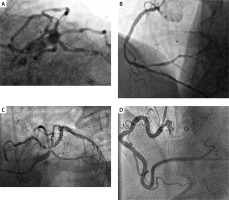Pentafurcation of the left main coronary artery (LMCA) is a rare finding in coronary angiography [1] or computed tomography angiography [2].
We present 2 patients with LMCA pentafurcation, who underwent different treatment strategies for their coronary disease.
Patient 1. A 60-year-old male patient with diabetes mellitus and hypertension, an active smoker, was admitted with recurrent chest pain. Troponin T was elevated to 425 ng/l (upper limit norm (ULN): 14). Non-ST-elevation myocardial infarction was diagnosed. Coronary angiography revealed LMCA pentafurcation with multivessel disease, but without LMCA involvement (Figures 1 A, B). Transthoracic echocardiography showed preserved systolic function of both ventricles. After heart team discussion, staged percutaneous coronary angioplasty (PCI) of the right coronary artery and the left circumflex coronary artery with implantation of drug-eluting stents (DES) was performed.
Figure 1
Patient 1. A – Left main coronary artery dividing info five branches; B – right coronary artery – significant stenosis in the infero-lateral branch. Patient 2. C – Left main coronary artery dividing into five branches and atherosclerotic involvement at its division; D – right coronary artery without significant stenosis

Patient 2. A 61-year-old female patient with hypertension was admitted with unstable angina. Coronary angiography revealed LMCA pentafurcation with LMCA involvement (Figures 1 C, D). Modified Medina classification of her LMCA division involvement was 1-1-0-0-0-0. Subsequently, she underwent coronary artery by-bass grafting (CABG).
The prevalence of LMCA pentafurcation is unknown. The modified Medina classification may be used for the nomenclature of the involvement of LMCA division by atherosclerosis. However, the SYNTAX score was not tested for LMCA quadrifurcation lesions (and obviously for LMCA pentafurcation lesions). This especially matters for our both cases, where all branches of the LMCA are of similar size. Moreover, as shown before, the SYNTAX score has little (if any) predictive value in the case of outcomes for patients undergoing stenting of trifurcated LMCA [3]. Based on the sub-study from the EXCEL trial [4], selected patients with distal LMCA trifurcation disease may be considered for PCI. However (as is obvious), no such data are available for patients with distal LMCA quadrifurcation or LMCA pentafurcation disease. Finally, the percutaneous hybrid approach with DES into the main vessel and a drug-eluting balloon might be a treatment strategy for patients with coronary bifurcation disease [5]. Nonetheless, such an approach has not been tested for trifurcated or quadrifurcated distal LMCA disease. Taking into account the rarity of LMCA pentafurcation, the heart team decision is obvious. CABG seems to be the treatment of choice in the involvement of distal LMCA, dividing into five branches (unless serious contraindications for CABG are present). Other multi-vessel involvement (including proximal/mid LMCA) does not preclude PCI.








